Mike Jastrzebski's Blog, page 36
September 8, 2013
ACX-Turning your book into an audio book
By Mike Jastrzebski
I have been thinking for some time about having at least some of my books made into audio books. Several weeks ago I took the plunge and listed Key Lime Blues on ACX (Audio Creations Exchange) and started looking for a narrator. There are two ways to find a narrator, wait for them to contact you or listen to various narrators on the site and contact them.
As the author you have the option of requesting that the narrator do a fifty/fifty split on profits with no upfront cost to you, or if you want to keep all of the profits you can offer upfront payment. I listed my book as a fifty/fifty split. Some narrators are open to the split, some want only upfront payment. (To clarify, payment is due when the finished audio is uploaded to ACX.)
The first two days that my book was posted I received three unsolicited contacts, and I contacted four additional narrators that I picked after listening to samples. Of the four I contacted two got back to me and said they were working on a project. They both indicated when they would be available and asked me to contact them at that time if I was still looking for a narrator.
At this point I requested samples from the three who contacted me and put the others on the back burner. I sent off two pages of the book that I wanted to hear (pick a section of the book with several different characters so you can get a feel for the narrator’s vocal versatility). Within twelve hours I had my first audition audio and within five days all three of the narrators had submitted auditions.
So how do you choose the right narrator? It’s not easy. Both Mary (my wife and trusted editor) and I listened to the auditions multiple times. Each of the three auditions I received had some pros and cons. In the end we decided on Kevin Pierce as the narrator, and we decided to pay him upfront instead of a split. I guess I’m just too much of a control freak to split the profits with anyone else. There were three reasons we chose Kevin:
1) He was prompt. He contacted me within hours of our posting the book, he had a sample to us within a day, and he responded to any questions I had immediately.
2) We liked his voice.
3) When we felt one of the character’s voice didn’t fit our vision we had of the character, he changed it to our satisfaction.
Kevin was also fast once we signed the contract with him. In less than a week we had the entire recording in our possession and began the editing process. It took us a week to listen to the audio, decide on changes, and get back to him. The next day we had the changes.
The cost to us for this project was $1658.00. Once I sent the payment through Pay Pal he notified ACX that we had paid and they began the process of vetting the audio. This process takes 14-20 days, then the audio goes on sale.
By the way, Mary and I both love the way this audio turned out, and when we decide to have Dog River Blues recorded the first person we will contact will without a doubt be Kevin Pierce.
Also, the cover for the audio has to be a square cover. Here’s the cover for Key Lime Blues.
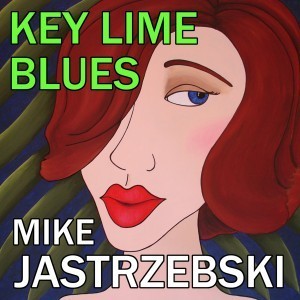
I’ll post about it and provide a link when the audio is available.
Share on Facebook
September 6, 2013
The most important tool

by Christine Kling
Whether it’s writing or sailing, people want to know what kind of tools you use to get the job done. At readings, people often ask writers the specifics of exactly how they do it. I remember back in the pre-computer days, I went to hear author Rita Mae Brown speak, and she said she always wrote with a Mont Blanc pen. I rushed out to buy one – until I saw the price. And we all know how important it is to take proper care of our tools, be they computers or socket sets.
The most important tool we use, though, is our bodies, and lately, I haven’t been taking care of that tool. And when you’re trying to write on a deadline, it’s more important than ever. I’m so smart when it comes to having 20/20 hindsight, but somehow that never prevents me from doing stupid things.
I am currently docked in Merritt Island, Florida which is some 180 miles north of the place I have called home for the last almost 30 years. Recently, I ordered some stuff from Sailrite to repair my dodger, and I forgot to change the address, and it was delivered to Fort Lauderdale. So, that was on my mind that I needed to get that package. My car had been acting up, and I have a trusted mechanic in Fort Lauderdale. The Terror needed a grooming and that was in Fort Lauderdale. I had stuff I wanted to put in my storage locker down south. You get the picture, right? The tipping point was when the folks in my critique group said they were meeting on Wednesday in a bar instead of the usual coffee shop because everybody was up for a little wine and whine. How could I resist that?
So, Wednesday morning I got up at 4:30 a.m. after only 4 hours sleep, and I drove south. I stopped at a truck stop for coffee and a greasy breakfast sandwich. I dropped my car off at the mechanics at 9:00 and walked in the rain to a library to work for the rest of the morning. After handing over the equivalent of my monthly pension to the mechanic, I barely made it to the critique group, and when I got to the apartment after 9:00, I stayed up to do email and more work. Of course, I didn’t sleep well in a different environment, and I again got about 4 hours of sleep.
I awoke at 5:00 a.m. sneezing and sniffling. I ran errands all day and grabbed junk food on the fly. I made 3 stops at Starbucks and by the time I headed out for the drive north at 4:00 p.m. I had a massive caffeine headache. I drove up I-95 with my box of tissues trying to see through watering eyes. When I got to the boat and remembered I needed to write a blog, I wanted to cry. Instead, I set my alarm, crawled into my bunk with my caffeine buzz and stared at the overhead willing my eyes to shut.
What’s up with this? I treat a pair of vice grips better than I treat my most important tool. If I can’t stay awake, I can’t write, I can’t sail.
So, the time has come to make a resolution. Just because I retired from the day job to write and live on a boat doesn’t mean I can let my body fall into complete disrepair. If I want to write the best book I’m capable of writing, it matters less what computer or software or pen I use. What matters most is the condition of my brain, my shoulders, my back. I’m going to eat better, go to sleep earlier, and exercise more. There — I said it to the world.
Now can I go take a nap?
Fair winds!
Christine
Share on Facebook
September 4, 2013
Brochures for the abnormal boat buyer…
C.E. Grundler
The other day I was looking at some new boat brochures.
No, don’t panic! Don’t think that I’m even considering letting go of my beloved Annabel Lee for something sleek, glossy, and modern. That’s just not happening, especially now that the great deck re-coring is nearing the end. (For real, dear readers! But that’s another post for another day.) No, it was more a case of morbid curiosity. In my eyes these newer boats, with their sloping bows, asymmetrical salon windows and roll-bar radar arches, all seem to look alike, and I’d always wondered what sort of interior lurked inside one of these shiny new vessels.
Well, for the most part it was pretty much as I expected. Page after page of brochure showed nicely dressed beautiful couples and smiling families enjoying perfect weather as their boats skimmed across smooth water. Sunsets, tranquil anchorages, all in the comfort of beautifully spacious cabins. More photos showed décor options and extras. Upholstery choices. Comfort groups. Even fitted sheets. Yes, fitted sheets were an available option. But as I reached the last page, there wasn’t a single picture of the one thing I really wanted to see – the engine room.
Apparently, I was told, engines weren’t something the normal boat buyer wants to see. No. Engines, it seems, are low on the list of concerns with a prospective customer making that all important decision. Fitted sheets, yes. Engines, not so much. It turns out, there are actual study groups, with actual normal boat buyers, (oddly enough, I’m yet to be invited,) to determine what it is new boat owners are looking for in a new boat, and these brochures are the direct result of these studies.
So there you have it. I’m not surprised to discover I’m not exactly a normal boat buyer. Which, I suppose, is a good thing. Otherwise, brochures would have pages of dirty, itchy people, sweating away in paint and epoxy stained clothing, surrounded by power tools and scraps of lumber, rolls of fiberglass and resin. Photos would show core construction, routing of fuel lines, detailed diagrams of hydraulic steering systems, and engine rooms galore! No fitted sheets, though.
Come to think about it, I’m starting to see the reasoning behind these new boat brochures.
Share on Facebook
Low tech cruising

by Christine Kling
I’ve lived my life a little bit backwards. The stereotype is the young person is a techie sort, and the old folks need help changing channels. I might be a geek now, but back when I started cruising in the 1970′s we were about as low tech as you can imagine.
Consider this: I sailed with Jim Kling from Lahaina, Maui to the Marquesas, across the islands of the South Pacific and then back to Hawaii and eventually on to California. Through all those thousands of miles, we didn’t even have a VHF radio on board. The one and only piece of electronics was a Heathkit depth sounder (I just Googled it for a link and found an online museum). For those who don’t remember those, they were sold as DIY kits that folks could put together at home with a soldering iron.
The boat was not insured, so Jim had invested his money in ground tackle. But in those days, we carried a hi-tensile Danforth and 350 feet of galvanized chain. The boat carried only 60 gallons of fuel, so the expectation on all those 1,000+ mile passages was that we would sail. We hand-pumped the water from the tanks, and when the wind quit, we waited instead of turning on the iron genny.
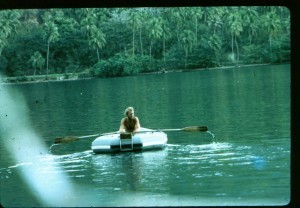 One of the biggest differences was the sort of dinghy people had. Hard bottom inflatables had not yet been invented. The boat didn’t have room to put a hard dinghy on deck. So Jim had gone for the biggest dinghy he could afford, and we carried a 12-foot oval-shaped Avon with a 2-stroke British Seagull outboard.
One of the biggest differences was the sort of dinghy people had. Hard bottom inflatables had not yet been invented. The boat didn’t have room to put a hard dinghy on deck. So Jim had gone for the biggest dinghy he could afford, and we carried a 12-foot oval-shaped Avon with a 2-stroke British Seagull outboard.
I remember one time in Hiva Oa in the Marquesas when we were being plagued by these tremendous gusts that would come down through the valleys. Though we were anchored in the lee of the island, the trade winds would blow over the top of the island and accelerate down through the valleys causing these occasional 50 knot gusts. Our donut dinghy was tied behind the boat and as these gusts hit us, we watched as the dinghy went airborne at the end of the painter. One morning a squall came through and the winds grew even worse. The third gust was the charm and the dinghy flipped over with the Seagull outboard attached. The outboard disappeared.
Jim had the presence of mind to grab a fishing weight and some monofilament and he dropped a fender-as-buoy in the 35-40 water where we were swinging on the hook. After the squall passed, we were pointing in a different direction, but we saw the buoy off our beam.
 When the weather cleared, Jim righted the dinghy and went out with a grapnel to drag for the outboard. He searched the area for 30 minutes and finally gave up. He went to retrieve his fishing weight from the bottom and it felt surprisingly heavy. When he pulled in the line, the monofilament was wrapped round and round the prop of the Seagull.
When the weather cleared, Jim righted the dinghy and went out with a grapnel to drag for the outboard. He searched the area for 30 minutes and finally gave up. He went to retrieve his fishing weight from the bottom and it felt surprisingly heavy. When he pulled in the line, the monofilament was wrapped round and round the prop of the Seagull.
That afternoon, we went ashore and cleaned out the outboard and washed it in a fresh water stream. We carefully dried it out, added a new plug, some new gas and zoom, she fired right up. We always used to say about that outboard, she never ran right, but she always ran. We weren’t speeding our way on a plane to far off anchorages, but she always ran.
We didn’t have iPods or Internet or movies on board. The only thing to do was to read. Because we didn’t have a generator or solar panels or a wind generator, we almost never ran the engine, and yet we didn’t think about charging the batteries. We used no electricity. For entertainment in the evenings, we used a Coleman kerosene lantern and we read books.
I think back on that time with fondness, but I know I could never go back. I am thrilled with the changes technology has brought to our lives. Sailors today who never crossed oceans back in the days before GPS will never love it and cherish it as I do. To me, my AIS radio is a marvel, and DSC is a terrific way to get ships to answer you back! I would never want to sail without my iPad and my digital charts and navigation programs. And crowd-sourcing charts through programs like Active Captain is changing the way charts are used.
While I may cherish my memories of those days of low-tech cruising, I’m riding the wave of change, and I’m not about to become one of those old ladies who can’t even program her DVR.
Fair winds!
Christine
Share on Facebook
September 2, 2013
Where’s The Weather?

(John Quill of Channel 22 – WWLP, Springfield, Mass – the source of my boyhood weather info…although notice the lack of specificity)
A well-known song heard along the waterfront includes the line The Weather Is Here. Unfortunately, that has not been the case for the Summer of 2013.
We’ve had a disproportionate share of bad weather across the lower 48 and that’s not even getting into a discussion about wild fires in the west. No less frustrating has been the lack of predicable forecasts. In fact, when we’ve had good days they’ve tended to come as unexpected surprises.
For those of us on the water, more time has been spent reading near-time info such as regional radar maps and electronic buoy data. The old weather proverbs have been helpful, too. You know:
Red sky in the morning, sailor take warning
Red sky at night sailor’s delight,
When the windows won’t open and the salt clogs the shaker,
The weather will favor the umbrella maker.
Mackerel sky, 24 hours dry.
There’s science to support these old adages (or at least that’s what Wikipedia says and good old Wiki is, after all, no less reliable than your smartest friend).
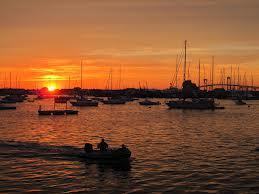
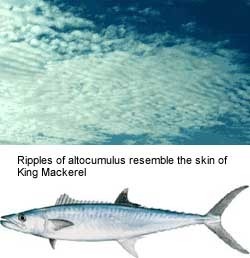
But this is the 21st century. Shouldn’t technology provide us with forecasts that are superior to lore passed down from 19th century mariners? The answer is an emphatic Yes.
Data scientists are using the tools of physics, statistical modeling, and supercomputing to develop advanced weather forecasting tools. As reported in Computerworld magazine, the National Oceanic and Atmospheric Administration (NOAA) has switched on two new supercomputers that are expected to improve weather forecasts. These two new computer systems are 213-teraflop machines and the government expects an increase in accuracy of no less than 15%.
But wait a minute, isn’t the common observation reported at the opening of this blog recognition that we’ve experienced really bad forecasts as of late? And by the way, what’s a teraflop?
My smart friend, Wiki, tells me that tera means trillion, as in one thousand billion, and a tera flop is equal to one trillion flops per second. Or, in this case, 213 trillion flops per second.
What? Flops? I am fairly certain we can all agree that the federal government is quite capable of creating flops with great ease, so now we’re adding supercomputing power to these folks so they can generate trillions of flops per second?
The answer is yes, but don’t worry. That really smart friend who has already received too much recognition tells me that a flop is a type of arithmetic calculation. The folks at NOAA are able to pump all kinds of weather data into these machines and make massive calculations to create weather modeling never before imagined. This is a real-world application of big-data that we’ve been hearing about, and I, for one, welcome this type of government R&D.
But, for a brief moment, let’s get back to that figure of 213 trillion computations per second. Where are they possibly getting that staggering amount of data?
Hmmm. Wait a minute, is it possible that the NSA is sending NOAA our emails, texts, voicemails, and smartphone photos to load them up on the weather Supercomputer? With 316 million people in the US and 7.1 billion around the globe, there’d be a treasure trove of GPS-identified weather photos, don’t you think? And consider how much idle chitchat we do texting and talking about the weather.
But let’s not get cynical. So far, Fox and CNN haven’t broken news of a National Weather Service contractor holding out in a Russian airport. Until they do, I am going to be looking to the sky, checking the salt shaker, and hoping that 213 trillion flops a second soon gives me a better window on the best time to set sail.
John Urban
Share on Facebook
August 30, 2013
Welcome guest Terry Shames & Lucky Lucy the Adventure Dog
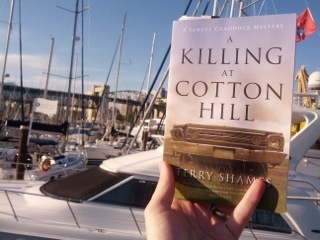
Our guest Terry Shames wrote her first novel, A Killing at Cotton Hill, on board the family catamaran
Lucky Lucy the Adventure Dog
by Terry Shames
I’m not sure what prompted my husband to decide we should get a dog to take with us when we went cruising on our catamaran, a Lagoon 440. We had been sailing for years without the assistance of a dog. But he was sure having a dog aboard would be just the thing. He convinced me it would be fun. Since he usually traveled in advance to the boat to get her ready for sailing, that meant that I was the one who would have to haul the dog through airports and onto planes. It meant making sure that we could take the dog on small planes when we were anchored off islands with a small airport. And checking the regulations on islands we were planning to visit to make sure they were dog friendly.
 After much investigation, we decided on an Australian terrier, a dog that wouldn’t get heavier than the airlines’ regulation 20 pounds and that was known for being adventuresome. We found our puppy in Tennessee. Instead of flying to get her, I drove there from Austin with my mother (who loved road trips). After we picked her up, Mother and I quickly discovered that Lucy was a self-reliant little dog who took our road trip in stride.
After much investigation, we decided on an Australian terrier, a dog that wouldn’t get heavier than the airlines’ regulation 20 pounds and that was known for being adventuresome. We found our puppy in Tennessee. Instead of flying to get her, I drove there from Austin with my mother (who loved road trips). After we picked her up, Mother and I quickly discovered that Lucy was a self-reliant little dog who took our road trip in stride.
The real test, though, was taking her on an airplane and then onto the boat. I could never have hoped for a dog more suited for adventure than Lucy was. As soon as I tucked her under the seat in front of me on the plane, she dropped off to sleep without a sound and slept the entire trip. When we got to the boat, she explored everything right away and it became “her” boat.
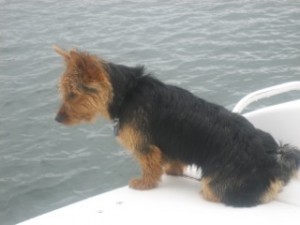 On our first trip, we were in Maine and the water was cold. As you can see from the picture, she eyed the water with great curiosity. Every day she watched it, mesmerized—and then one day, she simply leaped off the side. Luckily we watched her carefully all the time because we weren’t sure what she would do if she found herself in the water. But we needn’t have worried. She had seen us stepping off the swim ladder and somehow had processed in her doggy mind that this was the proper place to get on and off the boat. She swam right to the ladder and hauled herself aboard—a lot of scrambling was involved.
On our first trip, we were in Maine and the water was cold. As you can see from the picture, she eyed the water with great curiosity. Every day she watched it, mesmerized—and then one day, she simply leaped off the side. Luckily we watched her carefully all the time because we weren’t sure what she would do if she found herself in the water. But we needn’t have worried. She had seen us stepping off the swim ladder and somehow had processed in her doggy mind that this was the proper place to get on and off the boat. She swam right to the ladder and hauled herself aboard—a lot of scrambling was involved.
Like most dogs, although she learned right away where we wanted her to “do her business” on the boat, she always looked forward to getting land to a proper place.
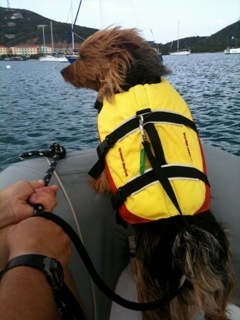
She loved going onto sand beaches. The first time she ever felt sand under her feet, she did a happy dance like I’ve never seen. She leaped into the air, dashed around, barked at the waves, and generally let us know that she was one happy dog.

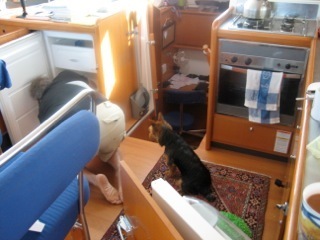
She learned how to help my husband repair things:
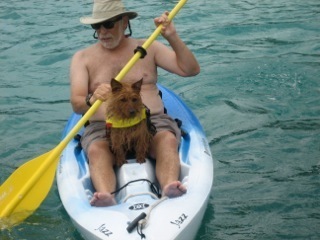
and loved going in the kayak.
And at the end of the day, she sprawled out, content to be with her people. But the best for me was that every morning when I wrote for three hours, she snuggled happily on the bed with me.
We sold the boat last year and got a second dog, thinking our boat days were over. But two months ago, my husband admitted that he needed another boat, a smaller one. So we bought our new boat, a 40-foot Catalina, a few weeks ago. The first thing my husband said was, “Now, how are both our dogs going to do on the boat?”

We’ll find out.
***************************************************************************************************
 Terry Shames grew up in Texas. She has abiding affection for the small town where here grandparents lived, the model for the fictional town of Jarrett Creek. A resident of Berkeley, California, Terry lives with her husband, two rowdy terriers and a semi-tolerant cat. She is a member of Sisters in Crime and Mystery Writers of America. Her second Samuel Craddock novel, THE LAST DEATH OF JACK HARBIN will be out in January 2014. Find out more about Terry and her books at www.Terryshames.com.
Terry Shames grew up in Texas. She has abiding affection for the small town where here grandparents lived, the model for the fictional town of Jarrett Creek. A resident of Berkeley, California, Terry lives with her husband, two rowdy terriers and a semi-tolerant cat. She is a member of Sisters in Crime and Mystery Writers of America. Her second Samuel Craddock novel, THE LAST DEATH OF JACK HARBIN will be out in January 2014. Find out more about Terry and her books at www.Terryshames.com.
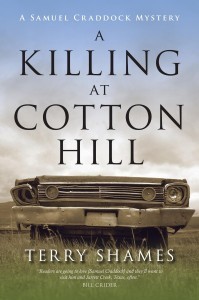 A KILLING AT COTTON HILL: A Samuel Craddock Mystery
A KILLING AT COTTON HILL: A Samuel Craddock Mystery
The chief of police of Jarrett Creek, Texas, doubles as the town drunk. So when Dora Lee Parjeter is murdered, her old friend and former police chief Samuel Craddock steps in to investigate. He discovers that a lot of people may have wanted Dora Lee dead—the conniving rascals on a neighboring farm, her estranged daughter and her surly live-in grandson. And then there’s the stranger Dora Lee claimed was spying on her. During the course of the investigation the human foibles of the small-town residents—their pettiness and generosity, their secret vices and true virtues—are revealed.
Reviews:
“…if you’re as fond of good writing as I am, it will be the characters in Cotton Hill that will keep the pages turning until late in the evening…” -Mysteryfile
“Shames’ novel is an amazing read. The poetic, literary quality of the writing draws you in…” -RT Book Reviews
“Readers will want to see more of the likable main character, who compassionately but relentlessly sifts the evidence. Convincing small town atmosphere and a vivid supporting cast are a plus.” -Publishers Weekly
Share on Facebook
August 29, 2013
It’s all a bit blurry…
C.E. Grundler
Last week I’d posted about how elements of my writing have spilled over into my daily life. They’re not obvious to the casual observer, but to anyone who has read my books, they might realize who, in fact my boat is named after, and more importantly, why. Hint: it has something to do with the sanity of taking on a project like her, or the lack thereof. And even the little bit of ink now proudly and permanently displayed on my arm – a simple and somewhat whimsical sea monster – holds a significance linked directly to my writing. But it goes both ways, and as Christine commented, sometimes the lines between fiction and reality can get a bit blurry.
As writers, our work springs from our imagination. Even as I’m going about my day-to-day business, my muses are on a scavenger hunt for ideas. Working in a marina means they don’t have to look far, at least for the sort of writing I do. In-tee-rest-ing customers and engines in need of overhaul, the smell of gear oil in the morning and the view of a thunderstorm engulfing the mountains across the river, the material is never-ending. Throw in more years of my own personal experiences than I prefer to admit, toss in a side of strange headlines I’ve tripped over, a dash of inspiration from reading other authors that I could only wish I wrote as well as, and mix well with a bit of wine and/or dark rum, and the ideas take form. Plot lines take shape and grow in that primordial ooze that is my mind, springing to life at odd hours of the morning, when I wake and fumble for my glasses, then ultimately scribble down illegible notes in the dark. There’s an added bonus if I can decipher my writing come morning, when I wake and try to translate it into something intelligible. I know some writers focus on classes and exercises, or head off to retreats and conventions. I might try those someday, though right now I can hear my muses snickering at the thought. No, they’d rather be strolling along the breakwater and feeling the damp wind off the river than to be cooped up in some room somewhere. They want reality, and large doses of it, so they can weave it into their fictional world.

The view from my corner of the river.
I realize it’s different for every writer. What works for me won’t work for the next guy, and vice-versa. And that’s not saying it even works for me all of the time. The last year’s been a rough one, but my muses and I are back on good terms these days, so I’m letting them have their fun. There’s no right road to writing, so long as you’re on a path that leads you to words on a page. Sometimes that path meanders away from the keyboard for a stretch. You can look at it like cooking – you can plan and consider recipes till the end of time, but if you really want something tasty, sometimes you need to get out of the kitchen and go shopping for fresh ingredients. Those ingredients, those experiences, are what makes our lives as writers, and therefore our writing, that much richer in the end. Even if, at times, it all gets a bit blurry.
Share on Facebook
August 28, 2013
Guns and cruising boats

Copra boat at the dock in Taiohae Bay, Nuku Hiva, Marquesas with gendarme’s post on the hill behind
by Christine Kling
Much has changed in the world of cruising sailboats between 1975 and today, but one thing that hasn’t changed is the question that all the non-sailors always ask: “Aren’t you afraid of pirates?” And it is that fear primarily that leads sailors to make a basic decision: whether or not to carry firearms aboard.
Guns can be a big problem for cruisers because most countries of the world have strict gun control laws. This means that when you arrive, if you carry guns, you must declare them to customs. Customs will then take them and hold them until you clear out. Once you get the guns back, you must leave immediately. This means that when you are cruising in the waters of that country, close to land, the time when you are most likely to need your guns, you can’t have them aboard, and you need to return to the same port where you entered to pick up your guns to depart. All that leads many cruisers to either not carry guns at all — or to find a very good hiding place on their boats and choose to not declare their guns to customs. The problem is that if they are found out, the penalty can be fines, confiscation of the boat and/or jail.
When we arrived in Taiohae Bay at Nuku Hiva in the Marquesas in May of 1975, we had no guns aboard because Jim didn’t want to have the hassle with customs. Every cruiser has to make that basic decision, and that was where Jim fell on the gun question. During the next couple of years that we cruised the South Pacific, we never felt threatened by local population of the islands and we never encountered pirates of any sort.

Skulls we found between the stones of a Marquesan marai remind us of how recently they were cannibals
In fact, the people of the Marquesas were extremely friendly. The main drag in the village was a dirt road and the gathering spot was at Rui, the baker’s house/shop where one could buy lovely French baguettes and cold beer, and since I spoke fluent French from having spent a year in France as a foreign exchange student, I could get us caught up on the local gossip. We were having a terrific time visiting with the locals. Two kids offered to take us up to swim at the base of the waterfall high up in the valley and when they showed up, they had a horse for me to ride. What I found so amazing about this trip was there seemed to be archeological treasures just lying around the jungle everywhere. We saw numerous stone tikis scattered throughout the jungle. On this long hike, the kids stopped and showed us a marai, a large rectangular stone platform that as recently as 100 years before had been used as a sort of temple for meetings, ceremonies, rituals and sacrifices. Before the arrival of Christian missionaries put a stop to it, the Marquesans had been cannibals, and the kids pulled out skulls from the stones of the marai to prove it.
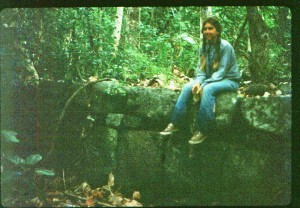 It was one afternoon when we were sitting outside Rui’s having a beer that Mark, the other crew aboard the Kathi II met the skipper of the big motorsailor I’ll call the Other Boat. They hit it off and the fellow invited Mark to go goat hunting with him. It seems that the north coast of Nuku Hiva is very steep and mountain goats clamber around on the cliffs. The locals go around in their open wood skiffs and shoot from their boats. The cliffs are so steep that once shot, the goats tumble into the sea.
It was one afternoon when we were sitting outside Rui’s having a beer that Mark, the other crew aboard the Kathi II met the skipper of the big motorsailor I’ll call the Other Boat. They hit it off and the fellow invited Mark to go goat hunting with him. It seems that the north coast of Nuku Hiva is very steep and mountain goats clamber around on the cliffs. The locals go around in their open wood skiffs and shoot from their boats. The cliffs are so steep that once shot, the goats tumble into the sea.
The next morning, the skipper of the Other Boat arrived at daybreak in his fancy dinghy to pick up Mark. He handed Mark a rifle and a burlap copra sack. He told Mark to keep the rifle hidden because he had not declared the guns. Off they went to meet the locals on the beach and transfer into the hunting boat. We couldn’t help but notice that about three inches of barrel was sticking out of Mark’s copra sack.
I don’t know if it has changed since we were there, but we noticed an odd relationship between the native Marquesans and the French. The locals who were former cannibals and fierce fighters resented their colonizers and held no love for them. The few French gendarmes were obviously nervous about their tenuous hold on islands where they were grossly outnumbered and not beloved. On the other hand, the locals were also quick to tattle to the authorities on both their neighbors and on the yachts.
 So it was later that afternoon when Jim and I were sitting on the steps of the baker’s house drinking our cold beers that we saw the triumphant hunters return. They had bagged a goat and the Marquesan men were all smiles. There was only one man on the island who was permitted to own a gun and ammunition was scarce. Thanks to some sailors who just wanted to go on the hunt, they were taking home meat for their families. The skipper of the Other Boat collected his guns and disappeared in his dinghy while Mark joined us for a beer. Just as he started to regale us with stories of the hunt, we heard the distant high-pitched wee-hoo, wee-hoo, wee-hoo of a European police siren. The gendarme truck (the only motor vehicle on the island) pulled up in a cloud of dust. The gendarmes climbed out, grabbed Mark, threw him in the back of the truck and took off back up the hill.
So it was later that afternoon when Jim and I were sitting on the steps of the baker’s house drinking our cold beers that we saw the triumphant hunters return. They had bagged a goat and the Marquesan men were all smiles. There was only one man on the island who was permitted to own a gun and ammunition was scarce. Thanks to some sailors who just wanted to go on the hunt, they were taking home meat for their families. The skipper of the Other Boat collected his guns and disappeared in his dinghy while Mark joined us for a beer. Just as he started to regale us with stories of the hunt, we heard the distant high-pitched wee-hoo, wee-hoo, wee-hoo of a European police siren. The gendarme truck (the only motor vehicle on the island) pulled up in a cloud of dust. The gendarmes climbed out, grabbed Mark, threw him in the back of the truck and took off back up the hill.
Jim and I each took a gulp of beer and he said, “Hmmm, now isn’t that interesting.” But before we even finished our beers, we heard that siren start up again, and down swooped the truck. This time they were looking for the captain of the Kathi II. In both encounters I had translated what the gendarmes wanted, so I was invited to join Jim in the back of the truck.
Moments later, I found myself in the stifling hot police station sitting on a chair with Jim on one side and Mark on the other. The head honcho gendarme was sitting behind the desk in front of us. He wore a Peter Sellers Pink Panther mustache and that high hat that looked a bit like an upturned saucepan on his head.
“Mademoiselle,” he would say to me. “This man,” he indicated Mark, “was observed with a rifle in the village and he says it belongs to him. The captain of your vessel did not declare any guns. What does your captain say to this.”
I would turn to Jim and translate. Jim stated, “I do not carry any guns aboard my boat and I have never seen that gun before today.”
Then Mark would say it was his gun, and Jim would lean around me and glare at him.
I would translate and the gendarme would say something like, “C’est pas possible,” and throw his hands into the air. “Do you expect me to believe that it is possible this man hid a gun aboard your boat?”
I’d throw my hands into the air and say in French, “I’m just the translator here.”
After nearly two hours of sweating us through this interrogation with Jim and Mark each repeating his line over and over and the gendarme threatening to arrest Jim as a gun smuggler, they finally let us go. We were told to return the following afternoon with the boat papers and our passports.
Once outside the office, we got the real story from Mark. The skipper on the Other Boat had offered him a paid crew position on the luxurious motor sailor, and Mark didn’t want to get him in trouble.
The next afternoon we took our documents in, but earlier in the day Mark had gone to the gendarme’s office with the skipper of the Other Boat and applied to change from our crew list to his. When Jim and I arrived, the officer was much nicer. The guys still stuck to their paradoxical stories, but the gendarme seemed to have figured things out. We were instructed to attend a court hearing in Papeete, the capitol of French Polynesia, on a particular date and set free.
A month later when we finally got to Papeete, the Other Boat had beat us there. His boat had been searched from stem to stern on arrival and they discovered not only guns, but also two small dirtbike motorcycles that were undeclared. The last we heard, the incident was going to cost him a small fortune just to stay out of jail. When we went to court, we were cleared of all wrongdoing and we got our papers back.
When we returned to the boat med-moored to quay on the Tahiti waterfront, we ran into the famous sailor/author Bernard Moitessier wearing a sarong, and I saw my old friend Jack who had sailed his folk boat down from Maui. I was beginning to feel a part of the cruising community, and we were now free to sail the rest of the Society Islands.
Fair winds!
Christine
Share on Facebook
August 26, 2013
Mystery Writers’ Key West Fest – Murder and Mayhem in Paradise
Michael Haskins – www.michaelhaskins.net
I want to run this idea by you readers. I have been asked by some local Key West writers to help put on an event somewhat on the lines of SleuthFest & Bouchercon. It would start off small, a meet-and-greet on Friday at the Smokin’ Tuna Saloon, with the mayor and a few city commissioners welcoming mystery writers and readers to the island. Books for sale and maybe a writer or two will give a reading. Of course, we’re in a Key West saloon, so who knows what else could happen?
Saturday morning there’d be two panels. Nine – 10 a.m., and 10:30 – 11:30 a.m. Lunch would follow, noon – 1:30 p.m. with a guest author talking. Still working on locale of where panels & lunch would be.
Two -3 p.m., a panel and 3:30 – 4:30 p.m. the last panel. The half hour between panels is to allow authors to sign books and people that want those books will not miss the beginning of the next panel.
We are working with a local theater to host an evening screening of a classic mystery, maybe “Lady in the Lake” or “The Maltese Falcon.” If you have an idea for a classic mystery movie, send it along.
Also, thinking of including a short ‘bar stroll’ from the Smokin’ Tuna, Hog’s Breath, Sloppy Joe’s, Pat Croce’s Rum Barrel and end at Schooner Wharf Bar on the waterfront.
Also, waiting for my friend Bill Murphy, owner of Fairvilla Megastore in Key West and Orlando. A classy, different adult themed store. I thought a cocktail get together in the story Saturday night might be fun and definitely something one would do in Key West.
Lot’s of things planned. Lots of help needed. Waiting on a hotel to sponsor the event with rooms for panelists and discounted room prices for guests of the festival. Rooms are at a premium right now, since four hotels have closed for renovation, but in 2014 we’re hoping prices will be more reasonable.
How about giving me a hand here and tell me if you’d be interested in such an event in Key West and if early April or early November are good times. Which month works best for you? What panel subjects would you like to see and what writers would encourage you to visit Mile Marker 0?
What we’ve tossed about for panels is: Women in mystery, how important in locale, hard-boiled & noir. Nothing is set in stone, so help out. Send me your ideas!
What price would you pay to attend the event, if price included everything but your hotel? Also, remember, there are lots of water sport activities for family members that aren’t interested in the festival, art galleries, shops and a few beaches. So this could be a family destination for a long weekend too.
This is early planning, so we are interested in everyone’s opinion.
Thank you.
Share on Facebook
August 23, 2013
Gratitude

by Christine Kling
I am writing tonight’s blog from my hotel room at the Westin in Seattle. To some people, that may not be a big deal, but for me, the bed in this room has a broader beam than my boat. Or so it seems. I certainly never stayed in a room like this when I was traveling in Thailand and the Philippines. I’ve never thought of myself as lucky, but tonight I feel like I am one of the luckiest people on the planet. I am here as a guest of my publisher, Thomas & Mercer, and the one emotion that I am filled with is gratitude.
I guess you could say that in the 21st century with the advent (invent) of the Kindle, traditional publishing has come under siege. There is a war going on for eyeballs on screens. Authors are the ones who produce much that content that goes on the screens. It sometimes seems like the legacy publishers have forgotten that, but this is something that Amazon knows at the core of their corporate structure. I’ve been here 24 hours now and all I hear (and see) is how Amazon puts the author at the center of all business equations.
See, I am here in Seattle as an invitee to Thomas & Mercer’s “On the Lam” conference. They invited all T&M authors who will have a book released in 2013 to come out here to Seattle for 3 days totally on their dime. They bought the plane tickets, paid for the hotel rooms, planned many extraordinary cocktail parties, galas, and a photo shoot for new author photos with the amazing art photographer John Keatley. Tomorrow we are all headed to Amazon headquarters for a tour, talk and continental breakfast. Afterwards, lunch will be aboard a big tour boat followed by a cruise to Lake Union. In the evening, there’s an elegant reception at the Chihuly Museum at the base of the Space Needle. There are about 65 of us here who accepted this invite for the all-expense paid trip to Seattle (including half a dozen UK authors).
 At tonight’s opening night cocktail party at the hosted bar in the lobby, all the talk among the authors was about how we, as authors, have never been treated so well by a publisher. They really want our opinions on covers, and when we say we think there should be changes, they go back to the drawing board and try again. They pay better royalties and they do so monthly. We have an online dashboard where we can see actual sales by the next day, so we always know how many books we’ve sold, and our final royalty statements are available online about fifteen days after the close of the month’s period. But you know what really wowed me? At every conference you get a goody bag and there usually are a few books in it. This time in our bags there was an actual Kindle (paperwhite) as well as a specially embossed leather cover!
At tonight’s opening night cocktail party at the hosted bar in the lobby, all the talk among the authors was about how we, as authors, have never been treated so well by a publisher. They really want our opinions on covers, and when we say we think there should be changes, they go back to the drawing board and try again. They pay better royalties and they do so monthly. We have an online dashboard where we can see actual sales by the next day, so we always know how many books we’ve sold, and our final royalty statements are available online about fifteen days after the close of the month’s period. But you know what really wowed me? At every conference you get a goody bag and there usually are a few books in it. This time in our bags there was an actual Kindle (paperwhite) as well as a specially embossed leather cover!
All this stuff, though, wouldn’t be that big a deal if they weren’t any good at selling books. You see that is where Amazon really shines! On Monday, August 12th, Amazon made Circle of Bones one of four books that were offered as the Kindle Daily Deal. They reduced the price to $1.99. All day I watched the ranking of my book as it climbed the charts. Just before midnight when I hit the key to refresh my screen for the hundredth time, I saw my book sitting at #1. Thanks to Thomas & Mercer, the woman who announced in seventh grade that she was one day going to be an author can now say that she is a #1 bestselling author. And in case you are wondering what it takes to make it to the top of the list, that day Amazon sold 9,642 copies of Bones!
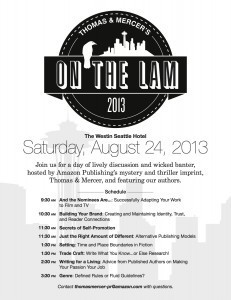 There are authors, publishers, and bookstore owners out there who like to paint Amazon and its CEO as the devil incarnate. Some bookstore owners even refuse to carry books published by any of the Amazon Publishing imprints. I think the publishing world needs to consider that in the competition to sign the best authors, with this conference, Amazon Publishing has announced Game on! All sixty-plus authors here are going to go back and talk, blog and let the world of authors know how great this publisher is. And as many of us keep saying again and again, there has never been a better time to be a writer.
There are authors, publishers, and bookstore owners out there who like to paint Amazon and its CEO as the devil incarnate. Some bookstore owners even refuse to carry books published by any of the Amazon Publishing imprints. I think the publishing world needs to consider that in the competition to sign the best authors, with this conference, Amazon Publishing has announced Game on! All sixty-plus authors here are going to go back and talk, blog and let the world of authors know how great this publisher is. And as many of us keep saying again and again, there has never been a better time to be a writer.
On Saturday, there will be sessions all day long and they are open to the public. I won’t be speaking, but I’ll certainly be attending. If you are in the neighborhood, come on down. You will see a bunch of the happiest authors on the planet.
Fair winds!
Christine
Share on Facebook



